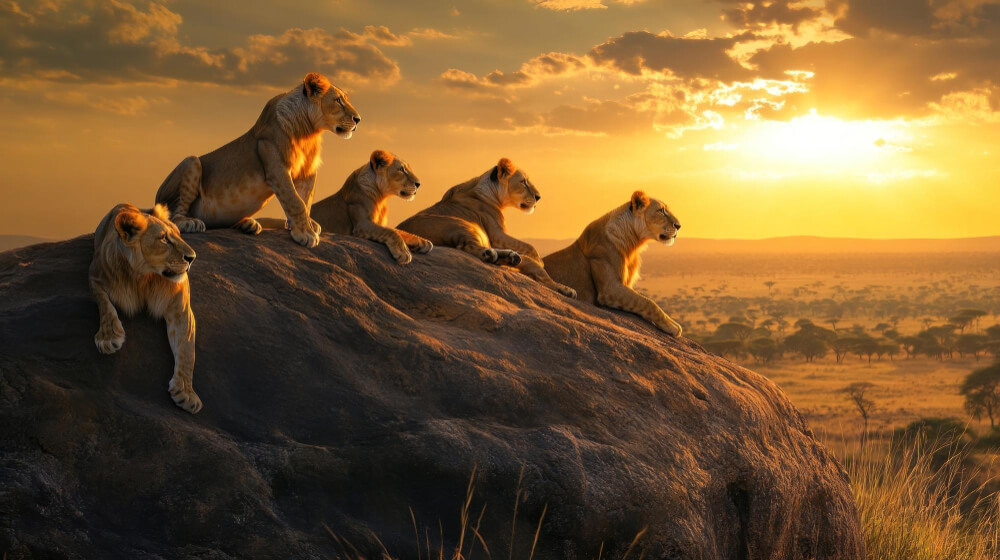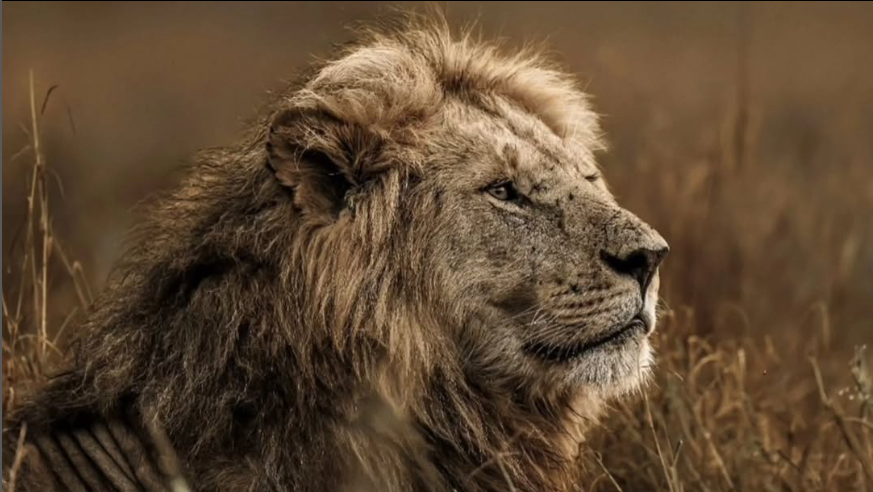The Kingdom of Lions in Serengeti National Park
The lion in Serengeti National Park is not just an icon — it’s the very heartbeat of Africa’s wilderness. Known as the “King of the Savannah,” the lion represents power, pride, and the raw drama of nature in action.
Home to over 3,000 lions, Serengeti National Park in Tanzania in East Africa hosts one of the densest lion populations in the world. Watching a pride of lions lazing in the grasslands or stalking prey during the Great Migration is a sight that defines the African safari experience.

How Many Lions Are in Serengeti National Park?
The Serengeti is estimated to have around 3,000 to 3,500 lions, organized into about 300 prides. Each pride includes 10–20 individuals, typically led by a dominant male and composed of related females and their cubs.
This high population density makes Tanzania’s Serengeti one of the best places in the world to observe lions in their natural habitat. Unlike other regions of Africa, lions here roam freely across vast territories, following herds of wildebeest and zebras throughout the year.
Where to See Lions in Serengeti National Park
While lions can be found throughout the Serengeti, certain areas are especially renowned for exceptional sightings.
1. Seronera Valley (Central Serengeti)
Often referred to as the “lion capital of Africa,” Seronera Valley offers the most consistent sightings year-round. The region’s rich prey base — including wildebeest, gazelles, and zebras — ensures lions rarely wander far.
Best for: Close-up encounters and photography opportunities.
2. Western Corridor (Grumeti River)
This area is known for lions hunting near the Grumeti River, especially during The Great Migration, when herds attempt perilous river crossings.
Best for: Witnessing lions hunt migrating herds.
3. Northern Serengeti (Mara River Region)
Near the Serengeti Mara, lions can often be seen during the migration season (July–October) when wildebeest cross the Mara River.
Best for: Action-packed predator-prey scenes.
4. Southern Plains (Ndutu Area)
During the calving season (January–March), lions in this region feast on vulnerable newborn wildebeests.
Best for: Seeing cubs and family dynamics within prides.
Lion Behavior in the Serengeti
Lions in Serengeti National Park display fascinating social behaviors that make them unique among big cats.
Social Structure: The Pride Life
Lions are the only social cats in the world, living in structured groups called prides.
- Each pride has 2–3 adult males, 5–10 lionesses, and their cubs.
- Females are the backbone of the pride — they hunt, raise cubs, and maintain social bonds.
- Males defend the territory from rivals, often engaging in fierce battles to maintain dominance.
Daily Routine: Kings of Relaxation
Lions spend up to 20 hours a day sleeping or resting, conserving energy for nighttime hunts. During the cooler hours, you may see them lounging under acacia trees or sprawled across termite mounds, surveying their territory.
Hunting Behavior: The Power of Cooperation
Lionesses work together to hunt, using strategic teamwork to ambush prey. They primarily target wildebeest, zebras, buffalo, and antelope — especially during migration season.
Males often join after the kill, asserting dominance at feeding time. The balance between cooperation and competition within a pride is a fascinating aspect of their survival.
Communication: Roars of the Savannah
A lion’s roar can be heard up to 8 kilometers away, signaling dominance, warning intruders, and keeping the pride connected across vast distances.
Territorial Range and Dominance
Each lion pride controls a territory of 20 to 400 square kilometers, depending on prey availability. Males patrol these boundaries regularly, marking them with scent and roars.
You may hear these territorial roars echoing at dawn and dusk during your Serengeti National Park safari — one of the most thrilling sounds in the wild.
The Lion and the Great Migration
During The Great Migration, the Serengeti transforms into a theater of survival, where lions are the leading predators.
As millions of wildebeests and zebras move across Tanzania’s Serengeti toward the Serengeti Mara, lions follow closely, exploiting the abundance of prey.
You can often see them waiting near rivers or open plains, where the weakest are easy targets.
This natural cycle not only sustains the lions but also balances the ecosystem.
Lion Cubs: The Next Generation
Lion cubs are born after a gestation period of around 110 days. A typical litter consists of 2–4 cubs, born blind and hidden for the first few weeks.
- Lionesses synchronize births, allowing multiple females to nurse and protect each other’s cubs.
- Cubs begin eating meat around three months old and start participating in hunts by one year of age.
- Sadly, only about 40% of cubs survive to adulthood, facing threats from predators, starvation, and rival males.
Lion Conservation in Serengeti National Park
While lions in the Serengeti are thriving, they still face challenges such as habitat loss, human-wildlife conflict, and disease.
Conservation efforts led by the Tanzania National Parks Authority (TANAPA), research groups like the Serengeti Lion Project, and local communities help protect these majestic creatures.
Sustainable Tanzania Tourism Packages contribute to lion conservation by supporting anti-poaching initiatives and community-based programs.
Fun Fact:
The Serengeti Lion Project, launched in the 1960s, is one of the world’s longest-running wildlife studies — providing vital insights into lion ecology and conservation.
Best Time to See Lions in Serengeti National Park
| Season | Months | Highlights |
|---|---|---|
| Dry Season | June – October | Best for lion sightings as grass is short and animals gather at waterholes. |
| Calving Season | January – March | See lionesses with cubs and abundant prey during birthing season. |
| Migration Season | July – October | Lions hunting herds in the Serengeti Mara and Grumeti River areas. |
If you dream of seeing lions hunting during The Great Migration in Serengeti , the northern Serengeti (Mara River region) offers the most dramatic action between August and October.
Safari Tips for Spotting Lions
- Early Morning Game Drives: Lions are most active at dawn and dusk.
- Visit the Seronera Valley: Guaranteed lion sightings almost every day.
- Go During the Dry Season: Sparse vegetation offers clearer views.
- Stay Near Waterholes: Prey gathers here, attracting lions.
- Bring Binoculars & Cameras: To capture intimate behavioral moments.
People Also Ask (FAQs)
1. How many lions are in Serengeti National Park?
Approximately 3,000–3,500 lions live in the park, one of the largest populations in Africa.
2. Where is the best place to see lions in Serengeti?
The Seronera Valley, Grumeti River, and Mara River regions offer the highest chances of sightings.
3. Are lions active during the day?
Lions are mostly nocturnal but can be seen resting or interacting during early morning and late afternoon.
4. What do lions eat in the Serengeti?
Their diet includes wildebeests, zebras, gazelles, and buffalo — mainly herbivores found in large herds.
5. When is the best time to see lions hunting?
During the dry season (June–October) and the Great Migration (July–October).
6. How dangerous are lions to humans?
Lions generally avoid humans, especially in protected areas, but they should always be observed from a safe distance.
7. Do lions migrate?
No, but they follow the migratory herds within their home range.
8. How do lions mark their territory?
They use scent markings, roaring, and patrols to defend their boundaries.
9. Why is Serengeti important for lions?
It provides abundant prey, vast territory, and natural protection, supporting one of the world’s healthiest lion populations.
10. What conservation efforts protect Serengeti lions?
Projects like The Serengeti Lion Project and eco-tourism initiatives support lion monitoring and anti-poaching efforts.
Final Thoughts: The Spirit of the Serengeti

From the Serengeti Mara in the north to the Seronera Valley in the center, lions rule every corner of this land. Their roars echo through Tanzania’s Serengeti, symbolizing the wild spirit of Africa itself.
Whether you’re on a Serengeti National Park Safari, capturing photographs of a pride under the acacia trees, or witnessing lions hunt during The Great Migration, this encounter will stay etched in your memory forever.
In the Serengeti, the lion isn’t just the king — it’s the soul of the savannah.
A giraffe in Tanzania gracefully roams the golden plains of the Serengeti in Africa, where the vast landscapes and stunning sunsets create an unforgettable scene. Many travelers visit this breathtaking destination on an African safari Tanzania adventure, seeking to witness the beauty of wildlife in its natural habitat. For couples looking for a unique romantic escape, Tanzania honeymoon packages often include luxurious stays and thrilling game drives across the Serengeti of Tanzania, making it the perfect blend of adventure and tranquility



